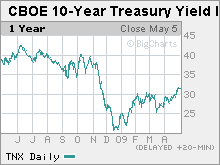Lending rate at new low, Treasurys flat
3-month Libor hits new low for second day. Prices for US debt mixed after $22 billion note sale.
NEW YORK (CNNMoney.com) -- Short-term lending rates touched another record low Wednesday in a sign of easier borrowing, while Treasury prices were mixed amid concerns about the banking sector and a major sale of U.S. debt.
In a continuing sign that credit is easier to get, 3-month Libor fell to a fresh all-time low of 0.97%, from 0.99% Tuesday, according to Bloomberg.com. The overnight Libor rate was unchanged at 0.24%.
Libor, the London Interbank Offered Rate, is a daily average of rates that 16 different banks charge each other to lend money in London. It is a closely watched benchmark and is used to calculate adjustable-rate mortgages. More than $350 trillion in assets are tied to Libor.
On Tuesday, the 3-month rate dropped below 1% for the first time since 1986, when the British Bankers Association started keeping records.
The TED spread, which measures the gap between 3-month Libor and the yield on the 3-month Treasury bill, now stands at roughly 78 basis points, down from 80 basis points Tuesday. A more narrow spread means banks are more willing to lend.
Banks, debt sale: Treasury prices rose after the government sold $22 billion of 10-year notes.
The Treasury Department said it received bids totaling more than $54 billion for the $22 billion of 10-year notes sold. That made for a bid-to-cover ratio of 2.47, up from 2.21 in February's auction, indicating demand for U.S. debt remains healthy.
Wednesday's auction comes on top of the $35 billion of 3-year notes the government sold Tuesday and ahead of a $14 billion offering of 30-year bonds Thursday.
The government has issued a record amount of debt in recent weeks to help fund its economic stimulus and financial rescue plans, among other things.
While demand for U.S. debt has remained relatively strong, many analysts worry that supply will weigh on prices as the economy recovers and investors seek higher returns in the stock market.
Meanwhile, the Federal Reserve said it bought $6.95 billion of Treasurys that mature in April 2012. The purchase was part of the central bank's ongoing plan to buy $300 billion of the assets to drive down interest rates.
Bond prices were also supported by concerns about the U.S. banking sector, which boosted demand for safe-haven assets such as Treasurys.
Government regulators are due to reveal the results of the "stress tests" conducted on the nation's largest banks Thursday, but results are already leaking out. Bank of America (BAC, Fortune 500), one of the 19 stress tested banks, faces a roughly $34 billion shortfall, according to published reports.
Stocks rose as investors weighed better-than-expected readings on the job market against the stress test jitters. The Dow Jones industrial average (INDU) gained 102 points, or 1.2%, according to early tallies.
Bond prices: The benchmark 10-year note rose 3/32 at 96 19/32, and its yield fell to 3.16% from 3.17% late Tuesday. Bond prices and yields move in opposite directions.
The 30-year bond slid 11/32 to 89 31/32, and its yield rose to 4.09% from 4.07%.
The 2-year note rose less than 1/32 to 99 27/32, and its yield was 0.97%.
The yield on the 3-month held steady at 0.19%. ![]()


